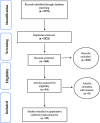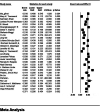Prevalence and factors related to urinary incontinence in older adults women worldwide: a comprehensive systematic review and meta-analysis of observational studies
- PMID: 33781236
- PMCID: PMC8008630
- DOI: 10.1186/s12877-021-02135-8
Prevalence and factors related to urinary incontinence in older adults women worldwide: a comprehensive systematic review and meta-analysis of observational studies
Erratum in
-
Correction: Prevalence and factors related to urinary incontinence in older adults women worldwide: a comprehensive systematic review and meta-analysis of observational studies.BMC Geriatr. 2022 May 25;22(1):454. doi: 10.1186/s12877-022-03111-6. BMC Geriatr. 2022. PMID: 35614400 Free PMC article. No abstract available.
Abstract
Background: Urinary incontinence is a common condition in the general population and, in particular, the older adults population, which reduces the quality of life of these people, so this study aims to systematically examine and meta-analyse the overall prevalence of urinary incontinence in older women around the world and the related and influential factors.
Methods: This report is a comprehensive systematic review and meta-analysis of the findings of research on urinary incontinence in older adults people across the world through looking for MEDLINE, Cochrane Library Sciencedirect, Embase, Scopus, ProQuest and Persian databases, namely iranmedex, magiran, and SID from January 2000 to April 2020, the heterogeneity of the experiments was measured using the I2 index and the data processing was done in the Systematic Meta-Analysis programme.
Results: In 29 studies and the sample size of 518,465 people in the age range of 55-106 years, urinary incontinence in older adults' women in the world based on a meta-analysis of 37.1% (95% CI: 29.6-45.4%) was obtained. The highest prevalence of urinary incontinence was reported in older adults' women in Asia with 45.1% (95% CI: 36.9-53.5%). Meta-regression also showed that with increasing the sample size and year of the study, the overall prevalence of urinary incontinence in the older adults women of the world decreased and increased, respectively, which were statistically significant differences (P < 0.05). According to studies, the most important factors influencing the incidence of urinary incontinence in older women are women's age (p < 0.001), obesity (p < 0.001), diabetes (p < 0.001), women's education (p < 0.001), delivery rank (p < 0.001), hypertension (p < 0.001), smoking (p < 0.001). They also have urinary tract infections (p < 0.001).
Conclusion: Given the high prevalence of urinary incontinence in older women around the world, health policy makers must consider control and diagnostic measures in older women and prioritize treatment and rehabilitation activities.
Keywords: Meta-analysis; Older adults; Prevalence; Urinary incontinence; Women.
Conflict of interest statement
The authors declare that they have no conflict of interest.
Figures






Comment in
-
Geriatrics.J Urol. 2022 May;207(5):1129-1131. doi: 10.1097/JU.0000000000002466. Epub 2022 Feb 10. J Urol. 2022. PMID: 35139649 No abstract available.
References
-
- Hu JS, Fiore PE. Urinary Incontinence in Women: Evaluation and Management. Am Fam Physician. 2019;100(6):339–348. - PubMed
Publication types
MeSH terms
Grants and funding
LinkOut - more resources
Full Text Sources
Other Literature Sources
Medical
Miscellaneous

